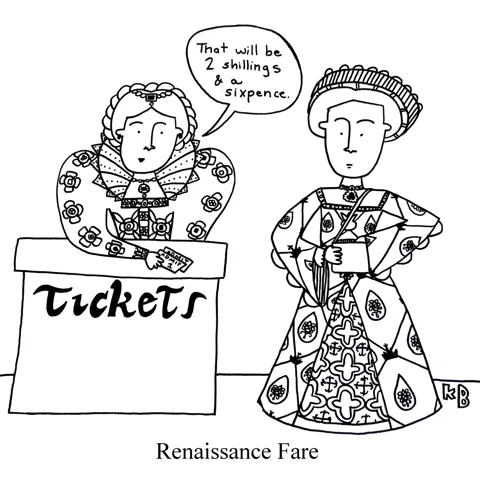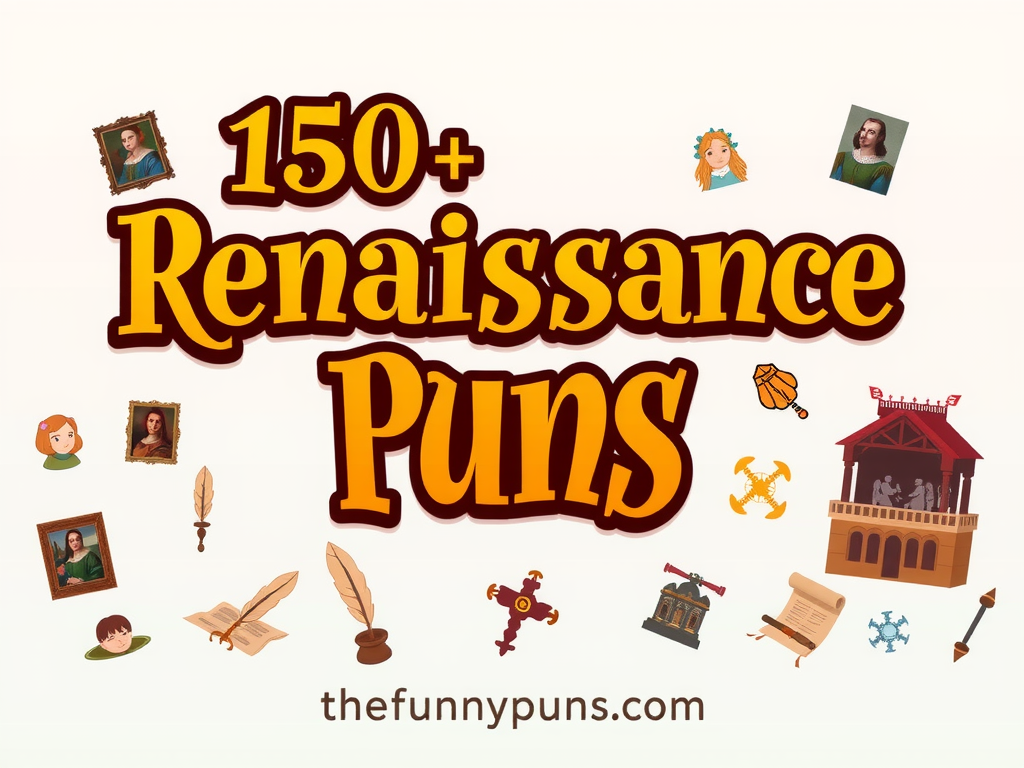The Renaissance was a time of great art, science, and culture. It also inspired humor, especially in the form of puns.
Renaissance puns bring a playful twist to historical references. They combine wit and a touch of history, creating a delightful blend of humor. Imagine Leonardo da Vinci making a joke or Shakespeare’s characters in a pun-off. These puns not only make us laugh but also connect us to the rich tapestry of Renaissance history.
They are a fun way to revisit the past with a modern sense of humor. Dive into the world of Renaissance puns and enjoy a unique mix of clever wordplay and historical charm.
Introduction To Renaissance Puns
Renaissance puns started in the 14th century. Artists and writers loved to play with words. They used clever puns to make people laugh. These puns often involved famous people from history. They brought humor to serious topics.
Renaissance puns are still funny today. They show how smart people were back then. These puns connect us to history. They also make learning fun. Kids and adults both enjoy them.
Famous Renaissance Figures
Leonardo da Vinci was a great mind. He was an artist and a scientist. He painted the famous Mona Lisa. His notebooks were full of ideas. Some ideas were about flying machines. Others were about human anatomy. He was curious about everything. Leonardo’s inventions were ahead of his time. He loved to experiment. His art and science work still inspire people today.
Michelangelo was a master sculptor. He made the famous statue of David. He also painted the Sistine Chapel ceiling. This took him four years to complete. His work shows great detail. Michelangelo’s sculptures look very real. He had a strong passion for art. His work is still admired by many. People visit Italy to see his masterpieces.
Literary Puns
Shakespeare loved wordplay. His puns make us laugh. For instance, in Romeo and Juliet, Mercutio says, “Ask for me tomorrow, and you shall find me a grave man.” Here, the word “grave” has two meanings. It means serious and a burial place. This double meaning is a typical Shakespeare pun.
Chaucer also enjoyed puns. In The Canterbury Tales, he writes, “He was a veray parfit gentil knight.” The word “parfit” sounds like “perfect.” This clever play on words shows Chaucer’s humor. His puns add fun to his stories and make them memorable.

Credit: punspedia.com
Artistic Humor
Artists from the Renaissance loved to play with images. They created hidden jokes in their paintings. These jokes are called visual puns. For example, a painting might show a person holding a pear. This could mean the person is pairing with someone. Another painting might show a knight. This could mean the person is night. These visual puns make the art fun.
Sculptors also enjoyed jokes in their work. They used clever wordplay. A statue might show a baker. This could be a pun on baking. Another statue might show a fish. It could mean someone is fishing for something. These sculptures make us smile. They show that art can be fun and playful.
Political Satire
Royal riddles often poked fun at the king. Clever wordplay was used to hide the real meaning. These riddles made people laugh and think. A riddle might ask, “What has a crown but isn’t a king?” The answer would be a rooster. Such riddles kept the court entertained.
Jesters used sharp wit to entertain. They joked about politics and the nobility. Their jokes were clever and often had hidden meanings. For example, a jester might say, “Why did the nobleman bring a ladder to court? To climb the social ladder!” These jokes made people laugh while hinting at the truth.

Credit: twitter.com
Scientific Jests
Galileo loved the stars, but he also loved jokes. He would say, “The Earth revolves around the Sun, just like my thoughts revolve around pizza!” His friends laughed every time. He also joked about his telescope. “With this, I can see my future. It looks… cloudy!” His humor was as bright as his discoveries.
Isaac Newton had a witty side too. He often said, “Gravity is the force that brings me back to bed!” His friends chuckled, imagining lazy mornings. He also quipped, “An apple fell on my head. It was the fruit of knowledge… literally!” Newton’s puns made science fun and light-hearted.
Philosophical Fun
Machiavelli loved playing tricks. He would say, “The ends justify the means.” It made people think. Some laughed at his clever wordplay. Others found it deeply philosophical. His mischief always had a lesson.
Erasmus enjoyed irony. He once said, “In the land of the blind, the one-eyed man is king.” This made people smile. His wit was sharp. His words were full of wisdom. Irony was his favorite tool.

Credit: katiebcartoons.com
Religious Ribbing
Explore the humor of the Renaissance with clever puns on religious themes. These witty jokes bring history to life. Enjoy a chuckle with well-crafted wordplay.
The Pope’s Punchlines
The Pope had a good sense of humor. He enjoyed sharing puns with visitors. One famous pun was about his hat. He said, “This hat is a real head-turner!” Everyone laughed. He also made jokes about cardinals. “Cardinals are great at baseball,” he would say. People loved his jokes. They made him seem more human.
Monastic Mirth
Monks loved to laugh too. They often told puns during meals. One monk joked about the bread. “This bread is on a roll!” he said. Another joked about the wine. “This wine is divine,” he said. Everyone laughed. Laughter made their days brighter. Even in a strict life, humor had its place.
Fashionable Funnies
The Renaissance brought many changes in fashion. Some clothes were quite unique. People joked about clothes all the time. A common jest: “Why did the knight wear chainmail? Because it was a link to the past!” Another funny quip: “Why did the dress go to school? It wanted to be smart!”
Accessories were also a source of fun. Hats were popular. People often said, “Why did the hat sit on a shelf? It needed a rest!” Jewelry jokes were common too: “Why did the ring go on a diet? It wanted to be light!” These jokes made people laugh and enjoy fashion even more.
Renaissance Puns Today
Renaissance puns still make people laugh. Many enjoy these historical jokes. They find clever ways to mix old and new. For example, using famous Renaissance art in memes. These jokes are simple yet smart.
Everyone can enjoy them. Even kids find them funny. The mix of past and present is enjoyable. Learning history can be fun this way. People share these puns online. They get many likes and shares.
Renaissance humor pops up in movies and shows. These jokes fit well in modern stories. Characters might dress like Renaissance figures. They speak in old-fashioned ways. This makes scenes funny and interesting.
Popular TV shows use these jokes. They make people laugh and think. It’s a fun way to learn about the Renaissance period. People love this mix of history and humor.
Frequently Asked Questions
What Are Renaissance Puns?
Renaissance puns are clever jokes related to the Renaissance period. They often play on words and historical references.
Why Are Renaissance Puns Popular?
They mix humor with history, making learning fun. Plus, they appeal to fans of the Renaissance era.
Can You Give An Example Of A Renaissance Pun?
Sure! “Why did the Renaissance artist never win? He could only draw. “
How Do Renaissance Puns Help In Learning History?
They make historical facts more engaging. This helps in remembering important details through humor.
What Makes A Good Renaissance Pun?
A good pun is clever, funny, and ties in with Renaissance themes or figures. It should be easy to understand.
Are Renaissance Puns Suitable For Kids?
Yes, they can be. Just ensure the puns are age-appropriate and easy to grasp.
Where Can I Find More Renaissance Puns?
You can find them online, in books about the Renaissance, or even create your own!
Do Renaissance Puns Need Historical Knowledge?
Some basic knowledge helps, but many puns are funny on their own. They often explain themselves.
Can Renaissance Puns Be Used In Teaching?
Absolutely! They can make lessons more engaging and help students retain information better.
Are Renaissance Puns Only In English?
No, they can be in any language, as long as they reference Renaissance culture or history.
Conclusion
Renaissance puns bring a playful twist to history. They can entertain and educate. Share these clever jokes with friends. You might spark laughter and curiosity. Enjoy the creativity of the past in a fun way. Discover more puns to keep the humor alive.
Let the Renaissance inspire your wit.


Comments